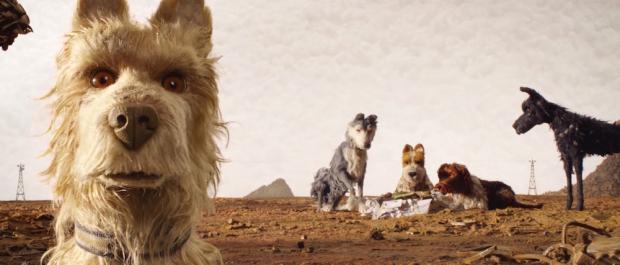Isle of Dogs
If the last two years of distressing national political events have left you with an unslaked need for ideological engagement, feel free to interpret Wes Anderson’s Isle of Dogs, his intricately clever and unusual stop-motion animated movie, as a cautionary fable about contemporary threats to justice and freedom. The movie does feature a demagogic political leader and his efforts at scapegoating and persecuting a segment of the population he rules over.
Personally, I don’t think that kind of response to the movie is worth the candle, but go ahead if it makes you feel any better. One notable reviewer has offered the opinion that Anderson’s work is inspired by our troubled times, but I don’t think his sensibility and imagination are fired by political reality and its discontents. He seems to answer to his own imagination and he rather obviously fabricates his own altered or original worlds.
The storyline concocted by Anderson along with three others, including actor Jason Schwartzman, is set in a somewhat futuristic Japan where the corrupt, authoritarian Mayor Koyabashi (Kunichi Nomura) of Megasaki City has decreed the banishment of all the city’s dogs to an island garbage dump, where they languish, starve and battle for food scraps. The exiles include Spots (Liev Schreiber), the electronically weaponized guard dog of the Mayor’s twelve-year-old ward, Atari (Koyu Rankin). Mayor Koyabashi’s dynasty has an ancient hatred of dogs based on events in history.
The distraught Atari flees to Trash Island to find Spots and takes up with a small band of former house pets (voiced by the likes of Bill Murray and Edward Norton), and one street dog, Chief (Bryan Cranston) who set off with him to find out what became of Spots. Meanwhile, in Megasaki the mayor conspires to control news of Atari’s absence and prevent efforts to bring the dogs back. (This part of the movie boasts Yoko Ono as a biochemical researcher, and how many movies can say that?)
Stop-motion animation is only realized with extensively meticulous craft, and Isle’s workmanship and inventiveness are remarkable. (Andy Gent was in charge of the puppet creation.) The dogs come off as more “real” than the human characters, who often appear cartoonish. One of the movie’s conceits is that the dogs’ barks are “translated” into English on the soundtrack, but the Japanese characters’ speech isn’t.
Anderson’s fancies and visions can certainly be engaging and amusing, but they can also become tediously self-indulgent and oppressively cute (as in his Grand Budapest Hotel from 2014). Isle goes both ways, but the balance is favorable, I think. There’s more than enough wit, charm and enchantment, particularly visually, to sustain audience involvement. Isle’s images are a marvel of intricacy, exquisite detail and dramatic compositions.
The movie is somewhat tonally uneven, mixing adventure and comic bits with cruelty and murder and appeals to sentiment. But this potential problem, and Isle’s rather flattened resolution don’t amount to serious enough deficiencies to thwart the film’s appeal and enjoyability.

